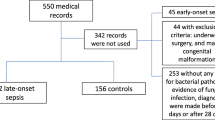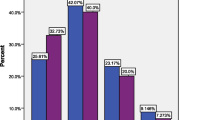Abstract
Objective
To determine the risk factors associated with culture-proven neonatal sepsis and identify predictors of mortality among them.
Methods
This prospective observational study was conducted in a tertiary care teaching hospital in South India over a period of 2 y. All admitted inborn and out born neonates with clinically suspected sepsis were included in the study. Blood culture was done for all neonates. Various factors associated with sepsis and mortality were identified. Chi-square test or Fisher’s exact test was used to compare two groups. The results of these tests were confirmed with logistic regression analysis.
Results
Of the 120 neonates, only 50 (41.6%) had a positive blood culture. Premature rupture of membranes (PROM) >24 h, Apgar score <6 at 5 min, birth weight ≤1.5 kg and mechanical ventilation were found to be the independent risk factors for culture-proven sepsis based on logistic regression analysis. Twenty-one (42%) of the 50 neonates with culture-proven sepsis died, while only 15 (21.4%) of the 70 neonates who were blood culture negative died (Relative risk, 1.69; 95% confidence interval, 1.13 to 2.53; P value 0.0263). Birth weight ≤1.5 kg, shock and lethargy were proved to be independent predictors of mortality.
Conclusions
The mortality rate was significantly high in neonates with a culture-proven sepsis compared to those with a negative blood culture. PROM >24 h, Apgar score <6 at 5 min, birth weight ≤1.5 kg and mechanical ventilation were independent risk factors for culture-proven sepsis, while lethargy, shock and birth weight ≤1.5 kg were independent predictors of mortality.
Similar content being viewed by others
References
Schaffner J, Chochua S, Kourbatova EV. High mortality among patients with positive blood cultures at a children’s hospital in Tbilisi, Georgia. J Infect Dev Ctries. 2009;3:267–72.
Kaistha N, Mehta M, Singla N, Garg R, Chander J. Neonatal septicemia isolates and resistance patterns in a tertiary care hospital of North India. J Infect Dev Ctries. 2009;4:55–7.
Anderson-Berry AL, Bellig LL, Ohning BL. Neonatal sepsis. e-Medicine 2010. [updated 2010 Feb 23; cited 2010 Sep 22]. Available from: http://emedicine.medscape.com/article/978352-overview.
Sundaram V, Kumar P, Dutta S. Blood culture confirmed bacterial sepsis in neonates in a North Indian tertiary care center: changes over the last decade. Jpn J Infect Dis. 2009;62:46–50.
National Neonatal Perinatal Database. NNPD report 2002–03 [cited 2010 Sep 22]. Available from: http://www.newbornwhoccorg/pdf/nnpd_report_2002-03 PDF; 2005.
Kayange N, Kamugisha E, Mwizamholya DL, Jeremiah S, Mshana SE. Predictors of positive blood culture and deaths among neonates with suspected neonatal sepsis in a tertiary hospital, Mwanza-Tanzania. BMC Pediatr. 2010;10:39.
Mackie TJ, McCartney JE. Practical medical microbiology. 14th ed. New York: Churchill Livingstone; 1996.
Zakariya BP, Bhat V, Harish BN, Arun Babu T, Joseph NM. Neonatal sepsis in a tertiary care hospital in south india: bacteriological profile and antibiotic sensitivity pattern. Indian J Pediatr. 2011;78:413–7.
Ogunlesi TA, Ogunfowora OB, Osinupebi O, Olanrewaju DM. Changing trends in newborn sepsis in Sagamu, Nigeria: bacterial aetiology, risk factors and antibiotic susceptibility. J Paediatr Child Health. 2011;47:5–11.
Stoll BJ, Hansen N, Fanaroff AA, Wright LL. Late-onset sepsis in very low birth weight neonates: the experience of the NICHD Neonatal Research Network. Pediatrics. 2002;110:285–91.
Kamath S, Mallaya S, Shenoy S. Nosocomial infections in neonatal intensive care units: profile, risk factor assessment and antibiogram. Indian J Pediatr. 2010;77:37–9.
Shitaye D, Asrat D, Woldeamanuel Y, Worku B. Risk factors and etiology of neonatal sepsis in Tikur Anbessa University Hospital, Ethiopia. Ethiop Med J. 2010;48:11–21.
Sankar MJ, Agarwal R, Deorari AK, Paul VK. Sepsis in the newborn. Indian J Pediatr. 2008;75:261–6.
Lawoyin TO, Onadeko MO, Sekun-Olarimoye EO. Neonatal mortality and perinatal risk factors in rural southwestern Nigeria: a community-based prospective study. West Afr J Med. 2010;29:19–23.
Ogunlesi TA, Ogunfowora OB. Predictors of mortality in neonatal septicemia in an underresourced setting. J Natl Med Assoc. 2010;102:915–21.
Contributions
VB, HBN, ZBP; involved in the conception of the study. VB, ZBP; conducted the study and collected the data. ABT, JNM; literature search, analyzed the data and drafted the manuscript which was critically reviewed and approved by VB. VB; the guarantor of this study.
Conflict of Interest
None.
Role of Funding Source
None.
Author information
Authors and Affiliations
Corresponding author
Rights and permissions
About this article
Cite this article
Zakariya, B.P., Bhat B, V., Harish, B.N. et al. Risk Factors and Predictors of Mortality in Culture Proven Neonatal Sepsis. Indian J Pediatr 79, 358–361 (2012). https://doi.org/10.1007/s12098-011-0584-9
Received:
Accepted:
Published:
Issue Date:
DOI: https://doi.org/10.1007/s12098-011-0584-9




